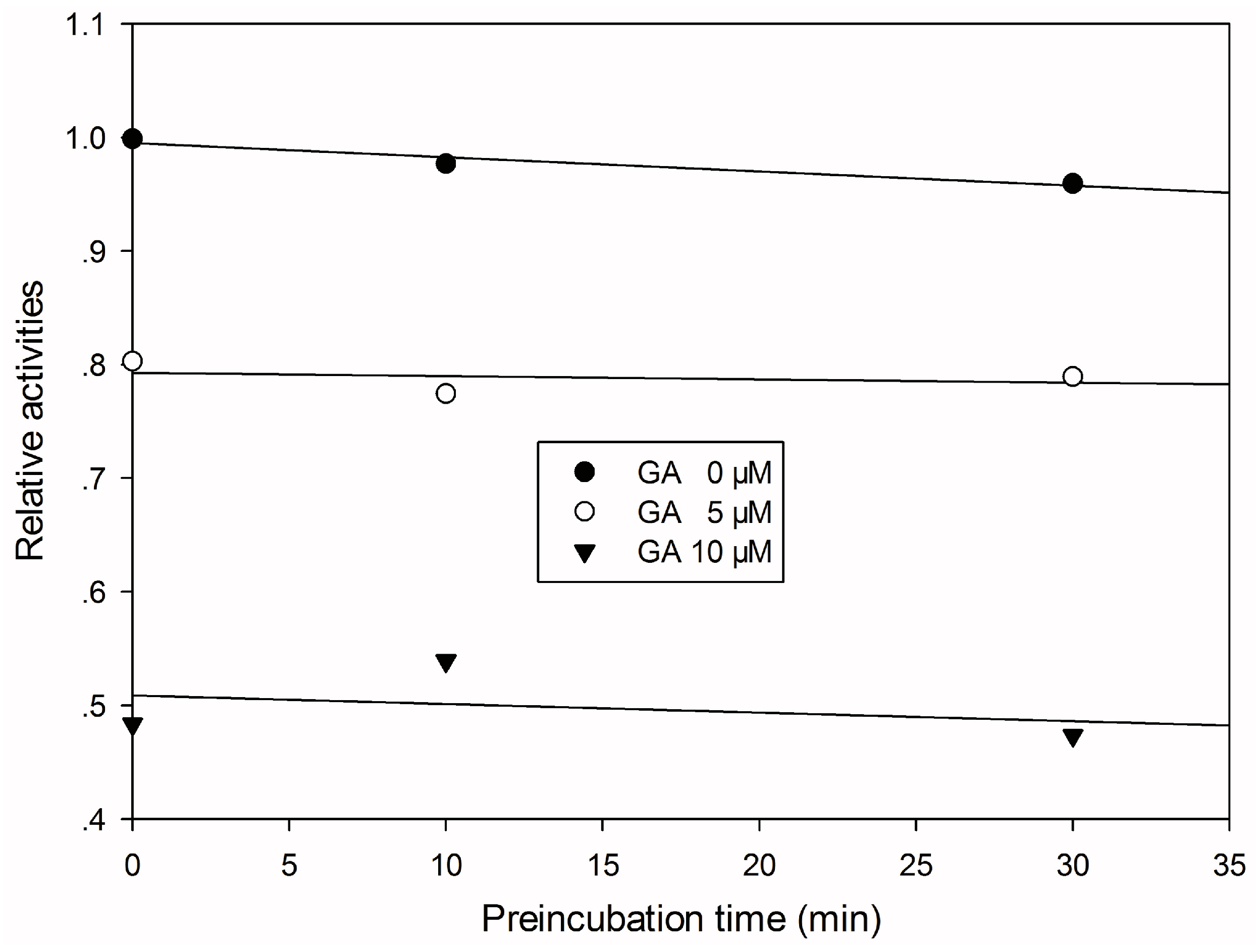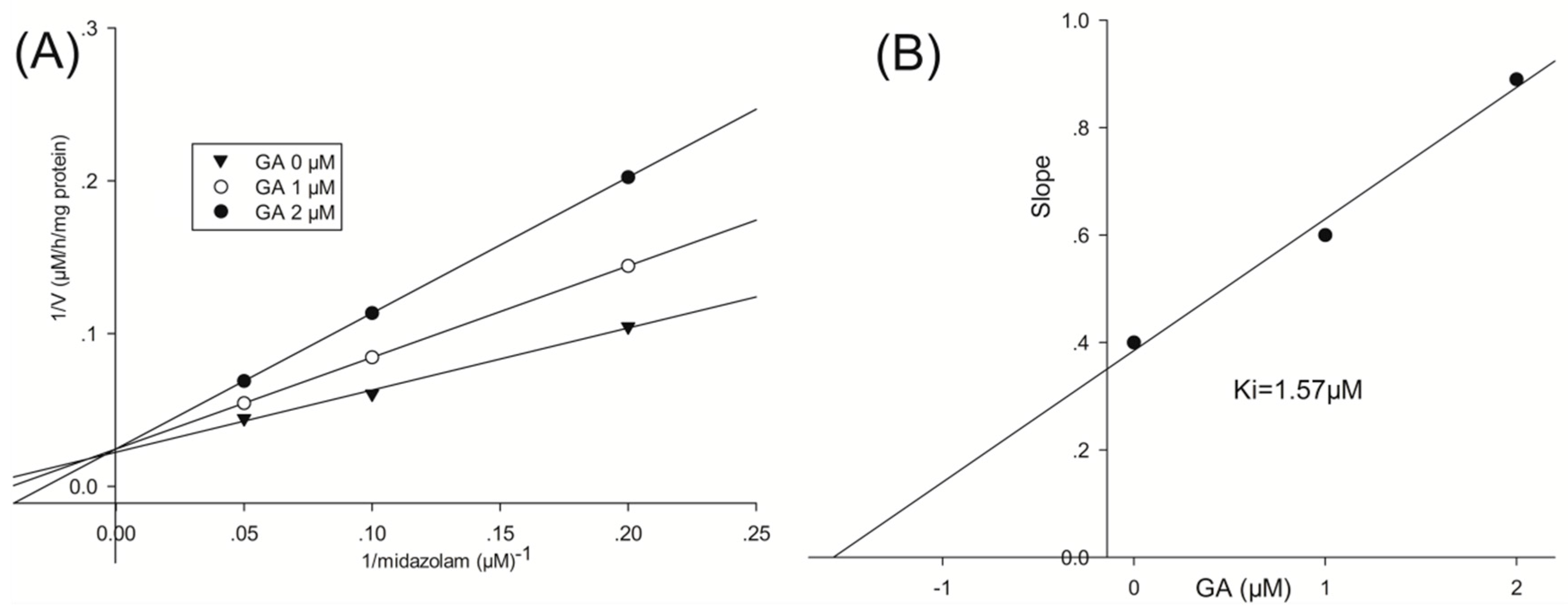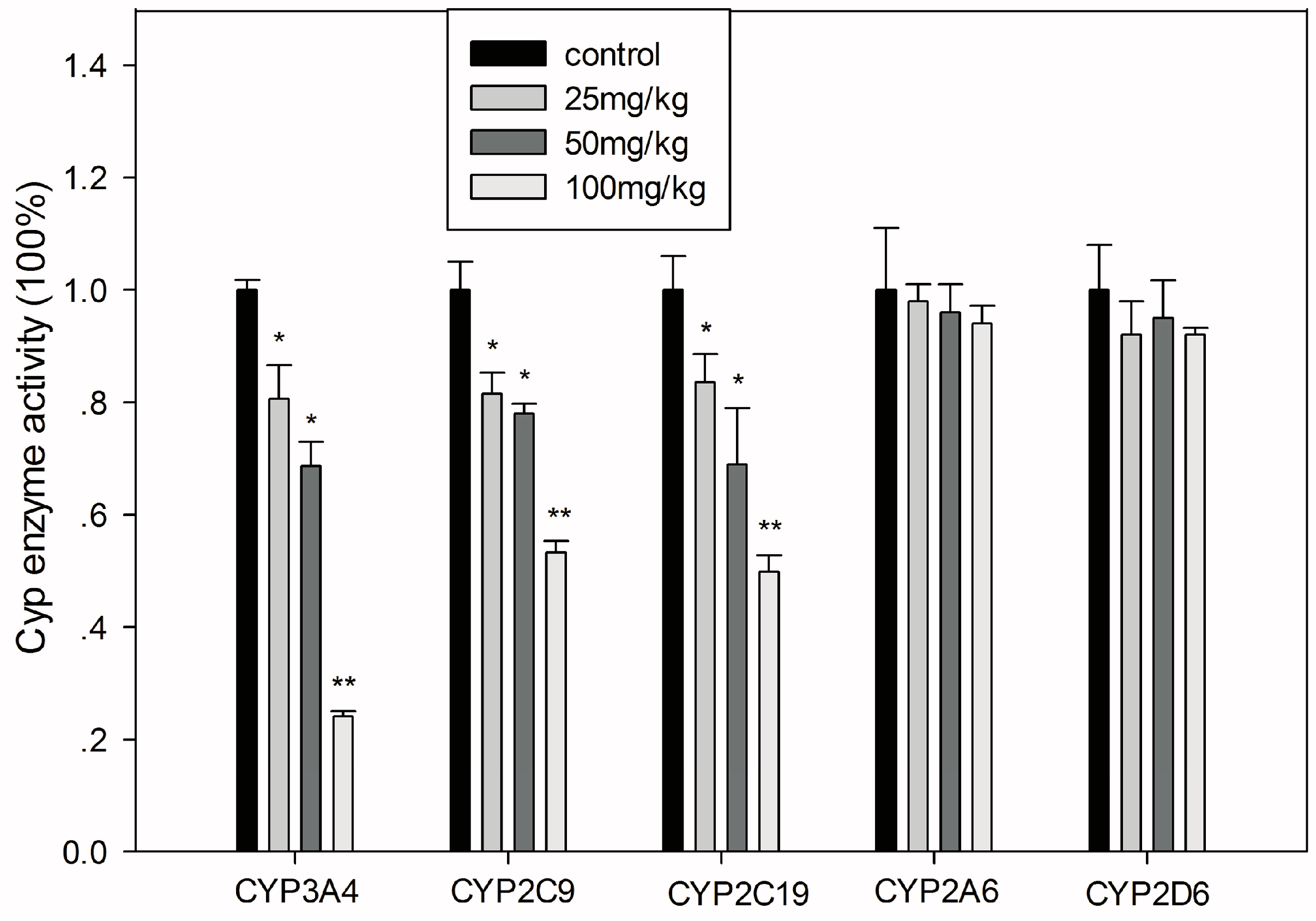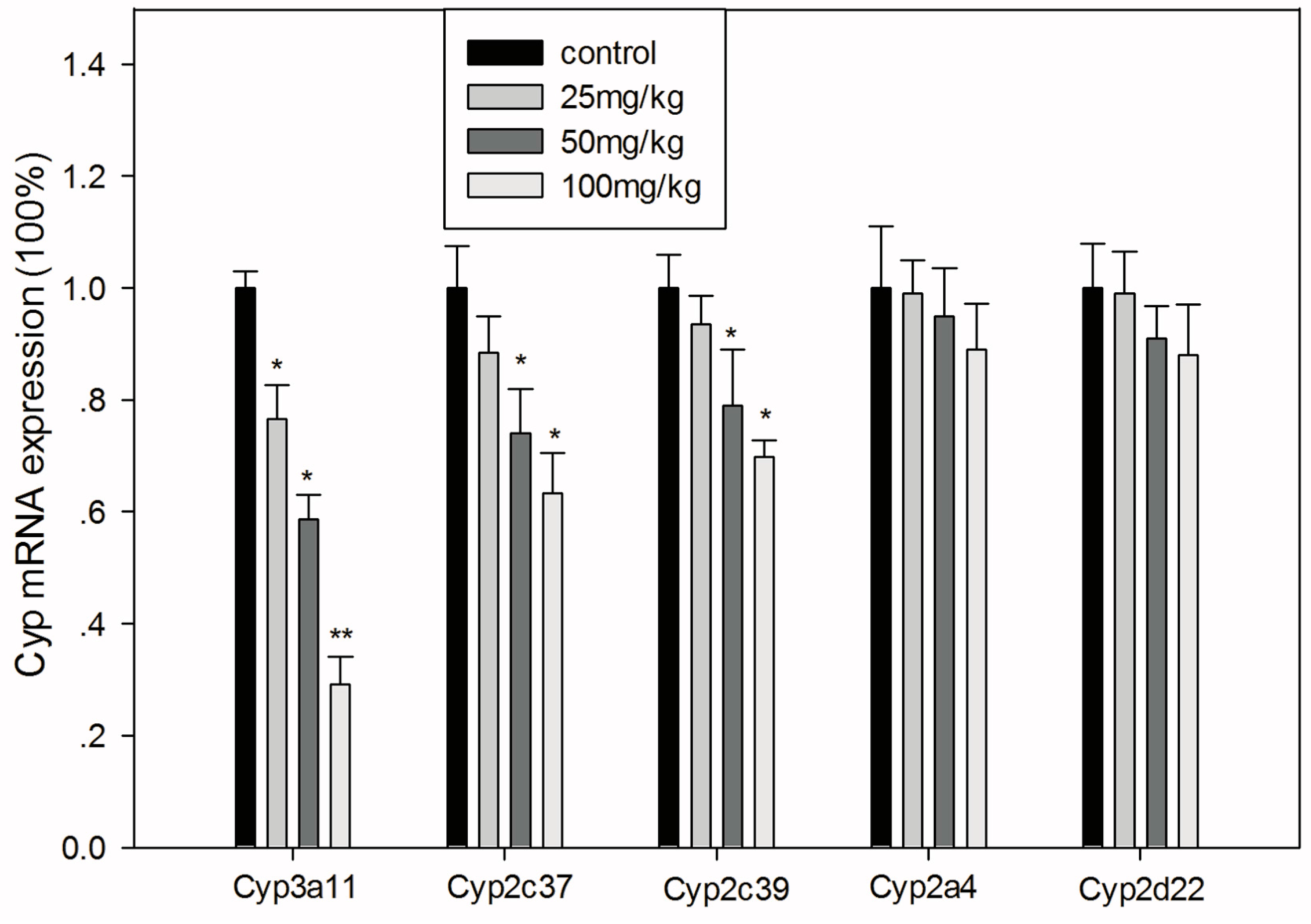In Vitro and in Vivo Inhibitory Effects of Glycyrrhetinic Acid in Mice and Human Cytochrome P450 3A4
Abstract
:1. Introduction
2. Materials and Methods
2.1. Chemicals
2.2. Animals and Treatments
2.3. Total RNA Extraction and Real-Time PCR Quantification
| Target | Accession Number | Forward Primer | Reverse Primer |
|---|---|---|---|
| Cyp2a4 | NM_009997 | GGAAGACGAACGGTGCTTTC | CCCGAAGACGATTGAGCTAATG |
| Cyp3a11 | NM_007818 | CGCCTCTCCTTGCTGTCACA | CTTTGCCTTCTGCCTCAAGT |
| Cyp2c37 | NM_010001 | ATACTCTATATTTGGGCAGG | GTTCCTCCACAAGGCAAC |
| Cyp2c39 | NM_010003 | GGAGACAGAGCTGTGGC | TAAAAACAATGCCAAGGCCG |
| Cyp2d22 | NM_019823 | GGGCCTTTGTTACCATGTTGG | TACTCGGCGCTGCACATCTG |
| β-actin | NM_007393 | TGTTACCAACTGGGACGACA | GGGGTGTTGAAGGTCTCAAA |
2.4. Liver Microsome Preparation and Determination of Cyp Activity
2.5. Inhibitory Effects of GA on Cytochrome P450s
2.6. Enzymatic Kinetic Study of Inhibition
2.7. cDNA-Expressed CYP3A4 Inactivation Assay
2.8. Statistical Analysis
3. Results
3.1. Inhibition of CYP450 Activity by GA in HLMs

3.2. Mechanism-Based Inhibition of CYP3A4 by GA


3.3. Inhibition of Recombinant CYP3A4 by GA
3.4. Inhibition of CYPs by GA in Mice

3.5. Effects of GA on the mRNA Expression Levels of CYPs

4. Discussion
5. Conclusions
Acknowledgments
Author Contributions
Conflicts of Interest
References
- Bensky, D. Chinese Herbal Medicine: Material Medica, 3rd ed.; Eastland Press: Seattle, WA, USA, 2004. [Google Scholar]
- Ahn, S.J.; Cho, E.J.; Kim, H.J.; Park, S.N.; Lim, Y.K.; Kook, J.K. The antimicrobial effects of deglycyrrhizinated licorice root extract on Streptococcus mutans UA159 in both planktonic and biofilm cultures. Anaerobe 2012, 18, 590–596. [Google Scholar] [CrossRef] [PubMed]
- Myrna, A.; Chie, A.; Mari, K.; Lin, D.; Ikuo, S.; Tutik Sri, W.; Maria Inge, L.; Hiroyuki, F.; Nobuo, K.; Hak, H. Anti-hepatitis C virus compounds obtained from Glycyrrhiza uralensis and other Glycyrrhiza species. Microbiol. Immunol. 2014, 58, 180–187. [Google Scholar]
- Huang, W.; Chen, X.; Li, Q.; Li, P.; Zhao, G.; Xu, M.; Xie, P. Inhibition of intercellular adhesion in herpex simplex virus infection by glycyrrhizin. Cell Biochem. Biophys. 2012, 62, 137–140. [Google Scholar] [CrossRef] [PubMed]
- Choi, A.Y.; Choi, J.H.; Hwang, K.Y.; Jeong, Y.J.; Choe, W.; Yoon, K.S.; Ha, J.; Kim, S.S.; Youn, J.H.; Yeo, E.J. Kang ILicochalcone A induces apoptosis through endoplasmic reticulum stress via a phospholipase Cγ1-, Ca2þ-, and reactive oxygen species-dependent pathway in HepG2 human hepatocellular carcinoma cells. Apoptosis 2014, 19, 682–697. [Google Scholar] [CrossRef] [PubMed]
- Khan, R.; Khan, A.Q.; Lateef, A.; Rehman, M.U.; Tahir, M.; Ali, F.; Hamiza, O.O.; Sultana, S. Glycyrrhizic acid suppresses the development of precancerous lesions via regulating the hyperproliferation, inflammation, angiogenesis and apoptosis in the colon of Wistar rats. PLoS ONE 2013, 8. [Google Scholar] [CrossRef] [PubMed]
- Chandrasekaran, C.V.; Deepak, H.B.; Thiyagarajan, P.; Kathiresan, S.; Sangli, G.K.; Deepak, M.; Agarwal, A. Dual inhibitory effect of Glycyrrhiza glabra (GutGard™) on COX and LOX products. Phytomedicine 2011, 18, 278–284. [Google Scholar] [CrossRef] [PubMed]
- Wu, T.Y.; Khor, T.O.; Saw, C.L.L.; Loh, S.C.; Chen, A.I.; Lim, S.S.; Park, J.H.; Cai, L.; Kong, A.N. Antiinflammatory/anti-oxidative stress activities and differential regulation of Nrf2-mediated genes by non-polar fractions of tea Chrysanthemum zawadskii and licorice Glycyrrhiza uralensis. AAPS J. 2011, 13, 1–13. [Google Scholar] [CrossRef] [PubMed]
- Bordbar, N.; Karimi, M.H.; Amirghofran, Z. Phenotypic and functional maturation of murine dendritic cells induced by 18 alpha- and betaglycyrrhetinic acid. Immunopharm. Immunotxicol. 2013, 36, 52–60. [Google Scholar] [CrossRef] [PubMed]
- Hong, Y.K.; Wu, H.T.; Ma, T.; Liu, W.J.; He, X.J. Effects of Glycyrrhiza glabra polysaccharides on immune and antioxidant activities in highfat mice. Int. J. Biol. Macromol. 2009, 45, 61–64. [Google Scholar] [CrossRef] [PubMed]
- Ohuchi, K.; Kamada, Y.; Levine, L.; Tsurufuji, S. Glycyrrhizin inhibits prostaglandinE2 production by activated peritoneal macrophages from rats. Prostaglandins Med. 1981, 7, 457–463. [Google Scholar] [CrossRef]
- Shibata, S. A drug over the millennia: Pharmacognosy, chemistry, and pharmacology of licorice. Yakugaku Zasshi 2000, 120, 849–862. [Google Scholar] [PubMed]
- Pompei, R.; Flore, O.; Marccialis, M.A.; Pani, A.; Loddo, B. Glycyrrhizic acid inhibits virus growth and inactivates virus particles. Nature 1979, 25, 689–690. [Google Scholar] [CrossRef]
- Park, H.Y.; Park, S.H.; Yoon, H.K.; Han, M.J.; Kim, D.H. Anti-allergic activity of 18beta-glycyrrhetinic acid-3-O-beta-D-glucuronide. Arch. Pharm. Res. 2004, 27, 57–60. [Google Scholar] [CrossRef] [PubMed]
- Tanaka, S.; Uno, C.; Akimoto, M.; Tabata, M.; Honda, C.; Kamisako, W. Anti-allergic effect of bryonolic acid from Luffa cylindrica cell suspension cultures. Planta Med. 1991, 57, 527–530. [Google Scholar] [CrossRef] [PubMed]
- Wang, L.; Yang, R.; Yuan, B.; Liu, Y.; Liu, C. The antiviral and antimicrobial activities of licorice, a widely-used Chinese herb. Acta Pharm. Sin. B 2015, 5, 310–315. [Google Scholar] [CrossRef] [PubMed]
- Liu, L.; Xiao, J.; Peng, Z.H.; Chen, Y. In vitro metabolism of glycyrrhetic acid by human cytochrome P450. Yao Xue Xue Bao 2011, 46, 81–87. [Google Scholar] [PubMed]
- Zhao, K.; Ding, M.; Cao, H.; Cao, Z.X. In-vitro metabolism of glycyrrhetinic acid by human and rat liver microsomes and its interactions with six CYP substrates. J. Pharm. Pharmacol. 2012, 64, 1445–1451. [Google Scholar] [CrossRef] [PubMed]
- Umegaki, K.; Saito, K.; Kubota, Y.; Sanada, H.; Yamada, K.; Shinozuka, K. Ginkgo biloba extract markedly induces pentoxyresorufin O-dealkylase activity in rats. Jpn. J. Pharmacol. 2002, 90, 345–351. [Google Scholar] [CrossRef] [PubMed]
- Qin, C.Z.; Ren, X.; Tan, Z.R.; Chen, Y.; Yin, J.Y.; Yu, J.; Qu, J.; Zhou, H.H.; Liu, Z.Q. A high-throughput inhibition screening of major human cytochrome P450 enzymes using an in vitro cocktail and liquid chromatography-tandem mass spectrometry. Biomed. Chromatogr. 2014, 28, 197–203. [Google Scholar] [CrossRef] [PubMed]
- Omiecinski, C.J.; Remmel, R.P.; Hosagrahara, V.P. Concise review of the cytochrome P450s and their roles in toxicology. Toxicol. Sci. 1999, 48, 151–156. [Google Scholar] [CrossRef] [PubMed]
- Williams, J.A.; Hyland, R.; Jones, B.C.; Smith, D.A.; Hurst, S.; Goosen, T.C.; Peterkin, V.; Koup, J.R.; Ball, S.E. Drug-drug interactions for UDP-glucuronosyl transferase substrates: A pharmacokinetic explanation for typically observed low exposure (AUCi/AUC) ratios. Drug Metab. Dispos. 2004, 32, 1201–1208. [Google Scholar] [CrossRef] [PubMed]
- Carreno, V. Seronegative occult hepatitis C virus infection: Clinical implications. J. Clin. Virol. 2014, 61, 315–320. [Google Scholar] [CrossRef] [PubMed]
- Wu, M.J.; Ke, P.Y.; Horng, J.T. RacGTPase-activating protein 1 interacts with hepatitis C virus polymerase NS5B to regulate viral replication. Biochem. Biophys. Res. Commun. 2014, 454, 19–24. [Google Scholar] [CrossRef] [PubMed]
- You, C.R.; Lee, S.W.; Jang, J.W.; Yoon, S.K. Update on hepatitis B virus infection. World J. Gastroenterol. 2014, 20, 13293–13305. [Google Scholar] [CrossRef] [PubMed]
- Lazarou, J.; Pomeranz, B.H.; Corey, P.N. Incidence of adverse drug reactions in hospitalized patients: A meta-analysis of prospective studies. JAMA 1998, 279, 1200–1205. [Google Scholar] [CrossRef] [PubMed]
- Calò, L.A.; Zaghetto, F.; Pagnin, E.; Davis, P.A.; de Mozzi, P.; Sartorato, P.; Martire, G.; Fiore, C.; Armanini, D. Effect of aldosterone and glycyrrhetinic acid on the protein expression of PAI-1 and p22 phox in human mononuclear leukocytes. J. Clin. Endocrinol. MeTable 2004, 89, 1973–1976. [Google Scholar] [CrossRef] [PubMed]
- Sadee, W. Gene-gene-environment interactions between drugs, transporters, receptors, and metabolizing enzymes: Statins, SLCO1B1, and CYP3A4 as an example. J. Pharm. Sci. 2013, 102, 2924–2929. [Google Scholar] [CrossRef] [PubMed]
© 2015 by the authors; licensee MDPI, Basel, Switzerland. This article is an open access article distributed under the terms and conditions of the Creative Commons by Attribution (CC-BY) license (http://creativecommons.org/licenses/by/4.0/).
Share and Cite
Lv, Q.-L.; Wang, G.-H.; Chen, S.-H.; Hu, L.; Zhang, X.; Ying, G.; Qin, C.-Z.; Zhou, H.-H. In Vitro and in Vivo Inhibitory Effects of Glycyrrhetinic Acid in Mice and Human Cytochrome P450 3A4. Int. J. Environ. Res. Public Health 2016, 13, 84. https://doi.org/10.3390/ijerph13010084
Lv Q-L, Wang G-H, Chen S-H, Hu L, Zhang X, Ying G, Qin C-Z, Zhou H-H. In Vitro and in Vivo Inhibitory Effects of Glycyrrhetinic Acid in Mice and Human Cytochrome P450 3A4. International Journal of Environmental Research and Public Health. 2016; 13(1):84. https://doi.org/10.3390/ijerph13010084
Chicago/Turabian StyleLv, Qiao-Li, Gui-Hua Wang, Shu-Hui Chen, Lei Hu, Xue Zhang, Guo Ying, Chong-Zhen Qin, and Hong-Hao Zhou. 2016. "In Vitro and in Vivo Inhibitory Effects of Glycyrrhetinic Acid in Mice and Human Cytochrome P450 3A4" International Journal of Environmental Research and Public Health 13, no. 1: 84. https://doi.org/10.3390/ijerph13010084





